

DIY surgical mask for Coronavirus SARS-2 / 2019-nCovid / Covid-19 virus – how to test is it safe? – Gechev.com. CWA17553 2020. Face Masks Really Do Matter. The Scientific Evidence Is Growing. Face masks are emerging as one of the most powerful weapons to fight the new coronavirus, with growing evidence that facial coverings help prevent transmission—even if an infected wearer is in close contact with others.
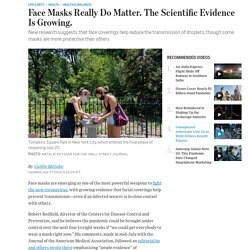
Robert Redfield, director of the Centers for Disease Control and Prevention, said he believes the pandemic could be brought under control over the next four to eight weeks if “we could get everybody to wear a mask right now.” His comments, made in mid-July with the Journal of the American Medical Association, followed an editorial he and others wrote there emphasizing “ample evidence” of asymptomatic spread and highlighting new studies showing how masks help reduce transmission. Hamster tests show masks reduce coronavirus spread: Scientists. HONG KONG: Tests on hamsters reveal the widespread use of face masks reduces transmission of the deadly coronavirus, a team of leading experts in Hong Kong said on Sunday (May 17).
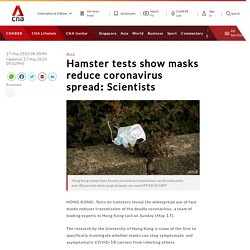
The research by the University of Hong Kong is some of the first to specifically investigate whether masks can stop symptomatic and asymptomatic COVID-19 carriers from infecting others. READ: Yes, wear a mask but when and why? Here’s what you need to know Led by Professor Yuen Kwok-yung, one of the world's top coronavirus experts, the team placed hamsters that were artificially infected with the disease next to healthy animals. N95 Respirators vs Medical Masks for Preventing Influenza Among Health Care Personnel: A Randomized Clinical Trial. Key Points Question Is the use of N95 respirators or medical masks more effective in preventing influenza infection among outpatient health care personnel in close contact with patients with suspected respiratory illness?
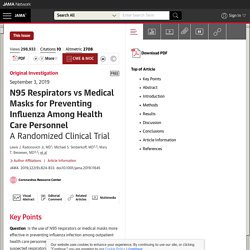
Findings In this pragmatic, cluster randomized clinical trial involving 2862 health care personnel, there was no significant difference in the incidence of laboratory-confirmed influenza among health care personnel with the use of N95 respirators (8.2%) vs medical masks (7.2%). Meaning As worn by health care personnel in this trial, use of N95 respirators, compared with medical masks, in the outpatient setting resulted in no significant difference in the rates of laboratory-confirmed influenza. Importance Clinical studies have been inconclusive about the effectiveness of N95 respirators and medical masks in preventing health care personnel (HCP) from acquiring workplace viral respiratory infections. Trial Registration ClinicalTrials.gov Identifier: NCT01249625 Box 1.
Signs. The Face Mask Debate Reveals a Scientific Double Standard. Masks-research. Cloth Face Mask Filter Imaging 20200404 (1) Study validates decontamination methods for re-use of N95 respirators. Loading Skip to main content Site Menu COVID-19 is an emerging, rapidly evolving situation.

Get the latest public health information from CDC: Get the latest research information from NIH: You are here Home » News & Events » News Releases News Releases Media Advisory Wednesday, April 15, 2020.
How to Put on and Remove a Face Mask - Disease Prevention and Control, San Francisco Department of Public Health. What is a face mask Face masks are one tool utilized for preventing the spread of disease.
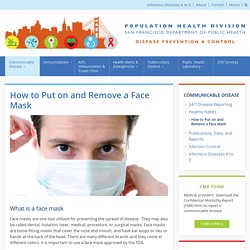
They may also be called dental, isolation, laser, medical, procedure, or surgical masks.
- The Washington Post. 3M™ FT-10 and 3M™ FT-30 Qualitative Fit Testing Kits. Filtering out Confusion: Frequently Asked Questions about Respiratory Protection. Masks research. I sewed and fit tested four different face masks... MakerMask: Science-Based Mask Designs for Community Makers. OSCMS - Face Masks. Jama radonovich 2019 oi 190087.
The 5 Best Face Masks for Virus Protection. Coronavirus came like a global earthquake, and no one knows when the world will stop quaking.

The seismic wave of this pandemic has shaken up our lives in too many ways to count. COVID-19, the most recent strain of novel coronavirus we’re contending with, has caused numerous illnesses, and unfortunately deaths, worldwide. We are all taking measures to stay safe and flatten the curve, from washing our hands to full on social isolation; these methods have been deemed effective with a resounding consensus. However, one safety measure has become a point of controversy and contention: the face mask. COVID-19: WHY WE SHOULD ALL WEAR MASKS — THERE IS NEW SCIENTIFIC RATIONALE. Masks-research. Masks do reduce spread of flu and some coronaviruses, study finds. Professional and Home-Made Face Masks Reduce Exposure to Respiratory Infections among the General Population. Use Cloth Face Coverings to Help Slow Spread. Advice on the use of masks in the community, during home care and in healthcare settings in the context of the novel coronavirus (COVID-19) outbreak.
The use of facemasks to prevent respiratory infection: a literature review in the context of the Health Belief Model. Face masks for COVID-19: A deep dive into the data. As COVID-19 cases increase sharply nationwide, some health experts are now recommending that seemingly healthy members of the public wear cloth masks when they’re out and about.
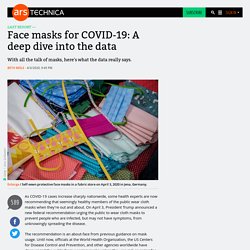
On April 3, President Trump announced a new federal recommendation urging the public to wear cloth masks to prevent people who are infected, but may not have symptoms, from unknowingly spreading the disease. The recommendation is an about-face from previous guidance on mask usage. Until now, officials at the World Health Organization, the US Centers for Disease Control and Prevention, and other agencies worldwide have discouraged the public from wearing masks unless they are sick or caring for someone who is sick.
They noted that there is little evidence to support mass masking and that the limited data we do have suggests it may reduce disease transmission only marginally at best. With evidence of benefits in short supply, experts also raised concerns about potential harms. As such, some experts—Dr. COMMENTARY: Masks-for-all for COVID-19 not based on sound data. Dr.
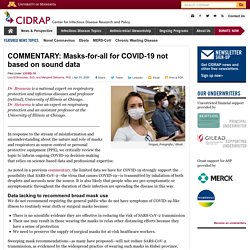
Brosseau is a national expert on respiratory protection and infectious diseases and professor (retired), University of Illinois at Chicago.Dr. Sietsema is also an expert on respiratory protection and an assistant professor at the University of Illinois at Chicago. The coronavirus mask debate, explained. Update, April 4: The CDC has announced new guidelines recommending the use of cloth face coverings in public.
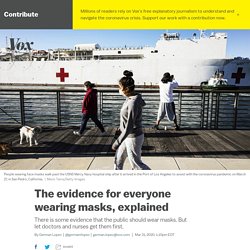
During the early days of the coronavirus pandemic, experts and officials cautioned against widespread public use of face masks. US Surgeon General Jerome Adams tweeted, “STOP BUYING MASKS!” He added that masks “are NOT effective in preventing general public from catching #Coronavirus, but if healthcare providers can’t get them to care for sick patients, it puts them and our communities at risk!” Should We All Be Wearing Face Masks? Here's Why Experts Are So Conflicted. Should members of the public be wearing face masks during the COVID-19 pandemic?
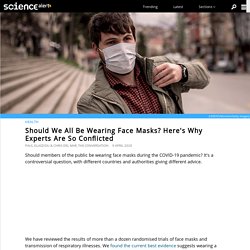
It's a controversial question, with different countries and authorities giving different advice. COVID 19 use face masks community. NPR Choice page. Turbulent Gas Clouds and Respiratory Pathogen Emissions: Potential Implications for Reducing Transmission of COVID-19. The current coronavirus disease 2019 (COVID-19) outbreak vividly demonstrates the burden that respiratory infectious diseases impose in an intimately connected world. Unprecedented containment and mitigation policies have been implemented in an effort to limit the spread of COVID-19, including travel restrictions, screening and testing of travelers, isolation and quarantine, and school closures. A key goal of such policies is to decrease the encounters between infected individuals and susceptible individuals and decelerate the rate of transmission.
Coronavirus and Surfaces: How Long Does COVID-19 Live on Surfaces? Get the latest news on the coronavirus pandemic here. The coronavirus that causes COVID-19 mainly spreads from person to person. When someone who is infected coughs or sneezes, they send droplets containing the virus into the air. A healthy person can then breathe in those droplets. You can also catch the virus if you touch a surface or object that has the virus on it and then touch your mouth, nose, or eyes. DEFINE_ME. We previously reported the detection of severe acute respiratory syndrome coronavirus 2 (SARS-CoV-2) in different clinical samples. Pan Y Zhang D Yang P Poon LLM Wang Q Viral load of SARS-CoV-2 in clinical samples. Lancet Infect Dis. 2020; () This virus can be detected on different surfaces in a contaminated site. Ye G Lin H Chen L et al. Stability of SARS-CoV-2 in different environmental conditions - The Lancet Microbe.